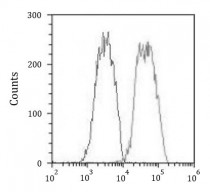ARG42212
anti-COMP antibody
anti-COMP antibody for Flow cytometry,Western blot and Human,Rat
Overview
| Product Description | Rabbit Polyclonal antibody recognizes COMP |
|---|---|
| Tested Reactivity | Hu, Rat |
| Tested Application | FACS, WB |
| Host | Rabbit |
| Clonality | Polyclonal |
| Isotype | IgG |
| Target Name | COMP |
| Antigen Species | Human |
| Immunogen | KLH-conjugated synthetic peptide between aa. 314-343 of Human COMP. |
| Conjugation | Un-conjugated |
| Alternate Names | MED; TSP5; Thrombospondin-5; COMP; THBS5; EDM1; PSACH; EPD1; Cartilage oligomeric matrix protein |
Application Instructions
| Application Suggestion |
|
||||||
|---|---|---|---|---|---|---|---|
| Application Note | * The dilutions indicate recommended starting dilutions and the optimal dilutions or concentrations should be determined by the scientist. | ||||||
| Positive Control | HUVEC | ||||||
| Observed Size | ~ 94 kDa |
Properties
| Form | Liquid |
|---|---|
| Purification | Purification with Protein A and immunogen peptide. |
| Buffer | PBS and 0.09% (W/V) Sodium azide. |
| Preservative | 0.09% (W/V) Sodium azide |
| Storage Instruction | For continuous use, store undiluted antibody at 2-8°C for up to a week. For long-term storage, aliquot and store at -20°C or below. Storage in frost free freezers is not recommended. Avoid repeated freeze/thaw cycles. Suggest spin the vial prior to opening. The antibody solution should be gently mixed before use. |
| Note | For laboratory research only, not for drug, diagnostic or other use. |
Bioinformation
| Database Links |
Swiss-port # P35444 Rat Cartilage oligomeric matrix protein Swiss-port # P49747 Human Cartilage oligomeric matrix protein |
|---|---|
| Gene Symbol | COMP |
| Gene Full Name | cartilage oligomeric matrix protein |
| Background | The protein encoded by this gene is a noncollagenous extracellular matrix (ECM) protein. It consists of five identical glycoprotein subunits, each with EGF-like and calcium-binding (thrombospondin-like) domains. Oligomerization results from formation of a five-stranded coiled coil and disulfides. Binding to other ECM proteins such as collagen appears to depend on divalent cations. Contraction or expansion of a 5 aa aspartate repeat and other mutations can cause pseudochondroplasia (PSACH) and multiple epiphyseal dysplasia (MED). [provided by RefSeq, Jul 2016] |
| Function | May play a role in the structural integrity of cartilage via its interaction with other extracellular matrix proteins such as the collagens and fibronectin. Can mediate the interaction of chondrocytes with the cartilage extracellular matrix through interaction with cell surface integrin receptors. Could play a role in the pathogenesis of osteoarthritis. Potent suppressor of apoptosis in both primary chondrocytes and transformed cells. Suppresses apoptosis by blocking the activation of caspase-3 and by inducing the IAP family of survival proteins (BIRC3, BIRC2, BIRC5 and XIAP). Essential for maintaining a vascular smooth muscle cells (VSMCs) contractile/differentiated phenotype under physiological and pathological stimuli. Maintains this phenotype of VSMCs by interacting with ITGA7 (By similarity). [UniProt] |
| Cellular Localization | Secreted, extracellular space, extracellular matrix. [UniProt] |
| Calculated MW | 83 kDa |
Images (2) Click the Picture to Zoom In
-
ARG42212 anti-COMP antibody WB image
Western blot: 20 µg of HUVEC whole cell lysate stained with ARG42212 anti-COMP antibody at 1:2000 dilution.
-
ARG42212 anti-COMP antibody FACS image
Flow Cytometry: HepG2 cells were fixed with 2% paraformaldehyde (10 min) and then permeabilized with 90% methanol (10 min). Cells were then incubated in 2% BSA to block non-specific protein-protein interactions followed by ARG42212 anti-COMP antibody (right histogram) at 1:25 dilution for 60 min at 37°C, followed by incubation with DyLight®488 labelled secondary antibody. Isotype control antibody (left histogram) was Rabbit IgG1 (1 µg/10^6 cells) used under the same conditions. Acquisition of > 10000 events was performed.







